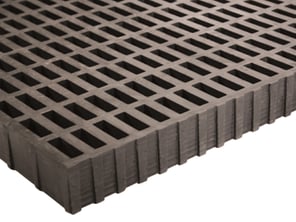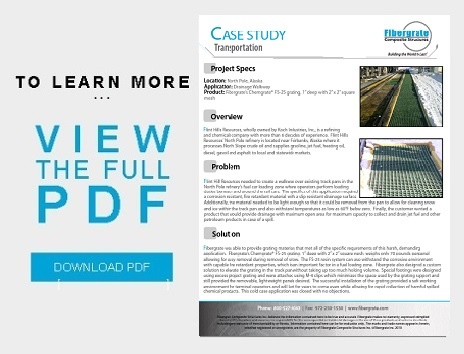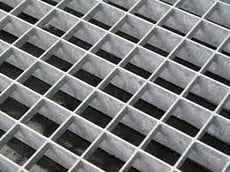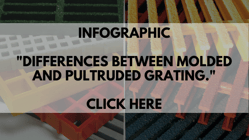There are many materials to choose from when it comes to industrial grating. Two of the most common...
Fiberglass Gratings vs. Metal Gratings: Choosing Project Materials
There are many materials to choose from when it comes to industrial grating. Two of the most common choices are fiberglass gratings (fiberglass reinforced plastic also known as FRP) and metal gratings (usually steel or aluminum). While they both serve the same purpose, they have distinct characteristics that make them better suited for certain types of applications. Understanding their differences can help you make an informed decision when selecting grating for your project.
Fiberglass Gratings vs. Metal Grating Overview
Fiberglass grating and metal grating both have their own unique qualities that make them well-suited for certain applications. It’s important to understand the differences between these two types of grates to determine which is right for your specific project. Let’s look at fiberglass grating first.
Fiberglass Grating
 Fiberglass reinforced plastic (FRP) grating is a great choice for both indoor and outdoor projects because it can withstand harsh weather conditions including salty air, UV exposure, and extreme temperatures as well as challenging chemical environments and health and safety issues, such as slip resistance. FRP grating requires very little maintenance. Dirt and other industrial substances can easily be washed away with just water and soap. Fiberglass gratings are lightweight yet strong, making the products easy to handle during installation, and also provide a safe and reliable walking surface.
Fiberglass reinforced plastic (FRP) grating is a great choice for both indoor and outdoor projects because it can withstand harsh weather conditions including salty air, UV exposure, and extreme temperatures as well as challenging chemical environments and health and safety issues, such as slip resistance. FRP grating requires very little maintenance. Dirt and other industrial substances can easily be washed away with just water and soap. Fiberglass gratings are lightweight yet strong, making the products easy to handle during installation, and also provide a safe and reliable walking surface.
Additionally, fiberglass grating is non-conductive, fire retardant, and corrosion resistant which are important considerations in certain industries or environments. It can easily be installed indoors or outdoors and only requires easily available hand tools such as a power saw to cut into the right size and shape for your application.
See how FRP gratings are designed to stand up to the challenges of an Alaskan winter and the requirement for a safe walking surface.
Metal Grating
 Metal gratings are known for their strength and durability. Properly selected, they can hold up under heavy loads or traffic areas without any issue. However, steel grating can corrode very quickly in certain environments, and while galvanized steel and aluminum stand up to the elements somewhat better, ongoing maintenance can still be an issue. Metal grating has been widely used for many years; however, increases in commodity pricing for metals like steel and aluminum make this type of grating less appealing compared to options like FRP. FRP gratings tend to last longer and cost less over the lifetime of the grating.
Metal gratings are known for their strength and durability. Properly selected, they can hold up under heavy loads or traffic areas without any issue. However, steel grating can corrode very quickly in certain environments, and while galvanized steel and aluminum stand up to the elements somewhat better, ongoing maintenance can still be an issue. Metal grating has been widely used for many years; however, increases in commodity pricing for metals like steel and aluminum make this type of grating less appealing compared to options like FRP. FRP gratings tend to last longer and cost less over the lifetime of the grating.
Choosing the Right Option for Your Project
When deciding between fiberglass and metal grating for your next job consider where the grating will be used (indoors or outdoors), how much weight will be placed upon it (heavy foot traffic vs vehicles), the risks of slips and falls, how much maintenance you want to put into caring for the grating (corrosion resistance) etc... Ultimately, all of these elements should factor into your decision, so you can make the best choice possible for your specific needs.
 Did you know? Fibergrate offers a variety of options for fiberglass gratings to fit your specific needs, including molded gratings and pultruded gratings. Both provide ideal options for commercial and industrial applications. Learn about the differences between the two with a helpful infographic.
Did you know? Fibergrate offers a variety of options for fiberglass gratings to fit your specific needs, including molded gratings and pultruded gratings. Both provide ideal options for commercial and industrial applications. Learn about the differences between the two with a helpful infographic.
Topics: FRP, Molded Grating, Pultruded Grating

